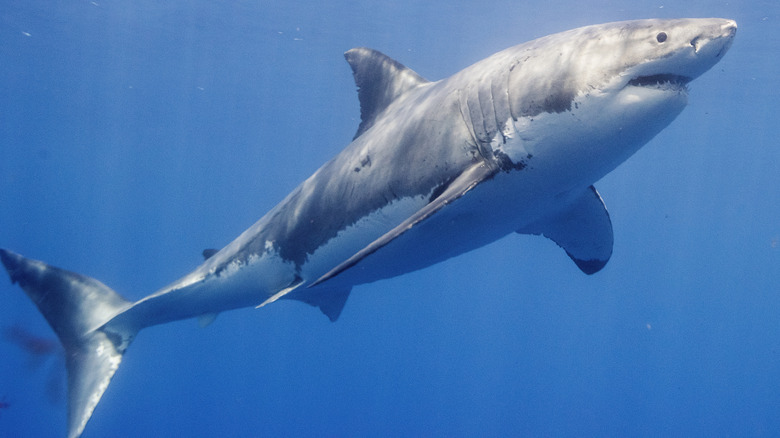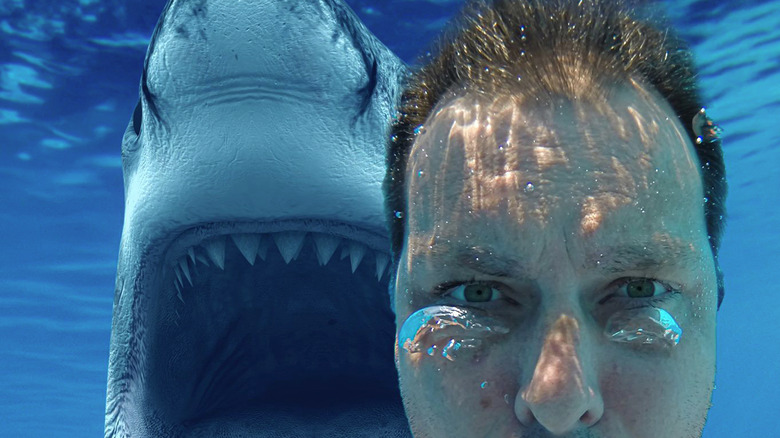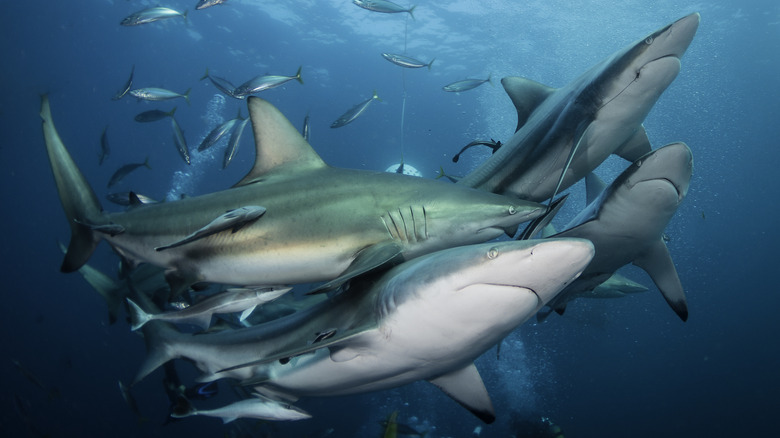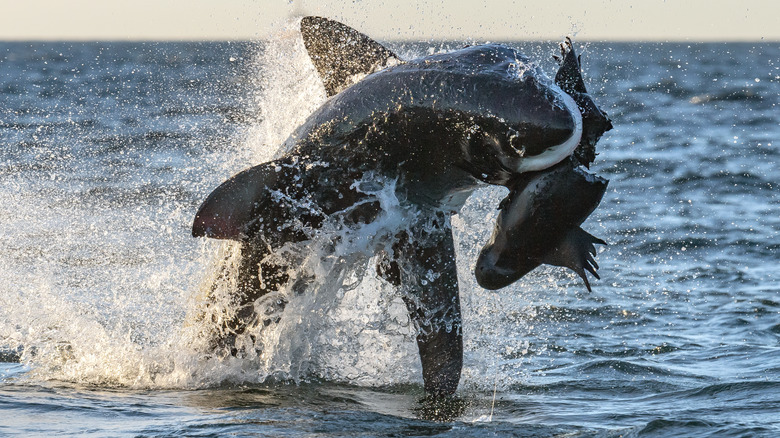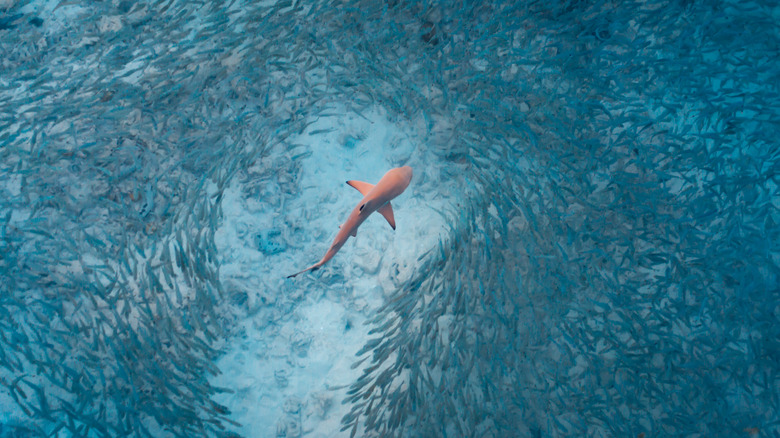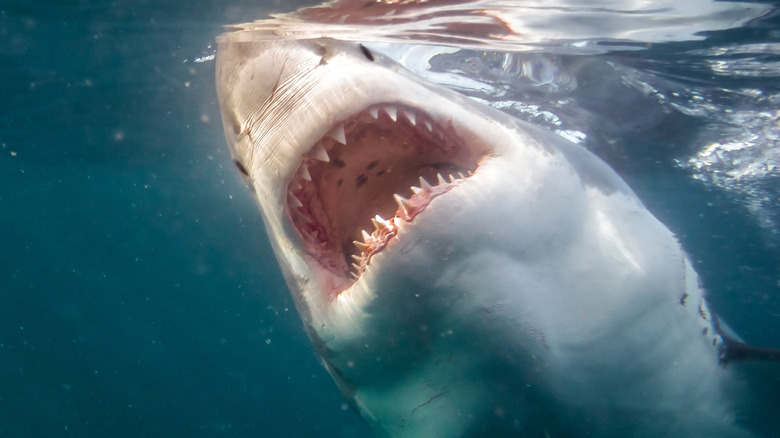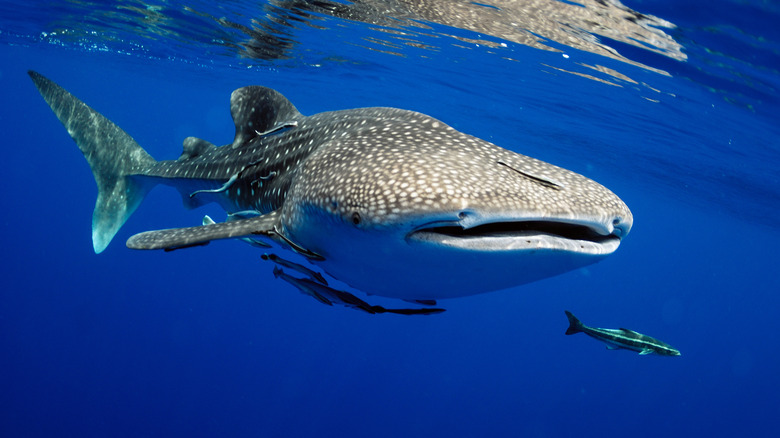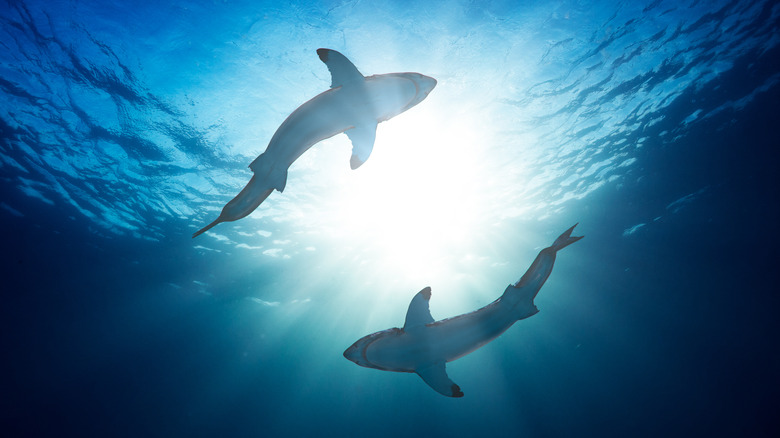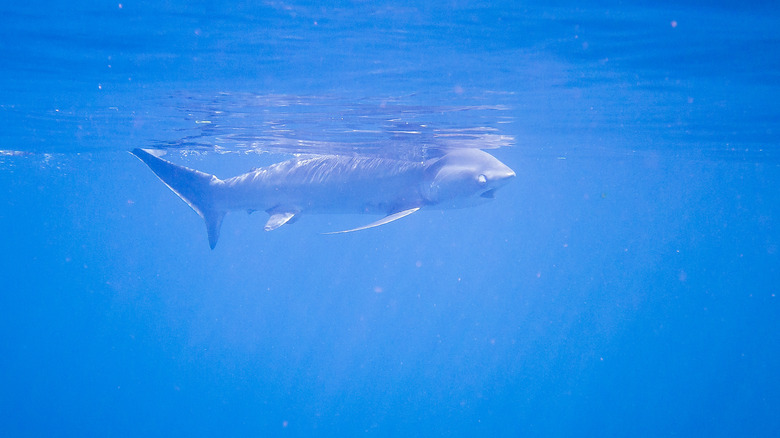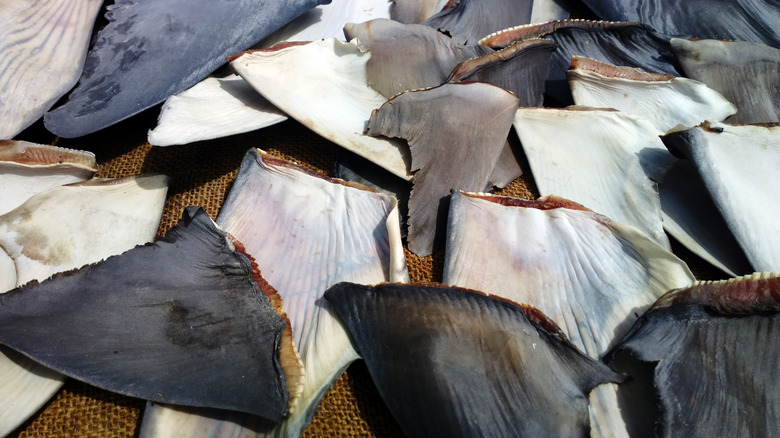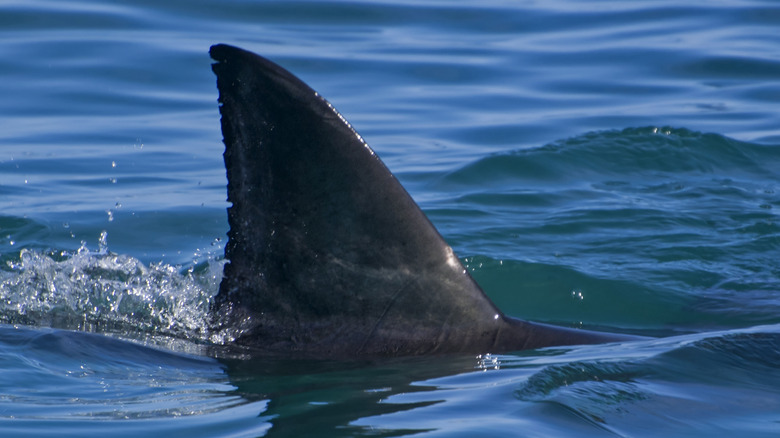False Things You Believe About Sharks
Admittedly, people tend to have a lot of negative (and sometimes downright terrifying) preconceived notions about sharks. Much of this is a result of how they're often portrayed in many works of popular culture. That's not to say, however, that man's fear of this aquatic predator is completely baseless. Take the great white shark, for example, which is perhaps the most well-known and iconic shark species: Its sleek shape, sharp senses, ginormous girth, coarsely serrated chompers, and bone-shattering bite truly make it an efficient hunter.
Still, there are quite a few things people believe about sharks that simply aren't true. Worse, some of these myths and misconceptions actually threaten the continued existence of these vital parts of the global food web. Obviously, this article isn't meant to convince you to go and hug a shark — please don't — but it can hopefully persuade more folks to change their perceptions about these magnificent denizens of the ocean.
Here's the truth behind twelve of the most widespread false ideas that humans believe about sharks.
False: Sharks frequently attack humans
It's not unheard-of for someone to have galeophobia, or a serious fear of sharks (via National Geographic). Aside from the fact that the shark encounters reported in the media typically involve the dangerous-looking types, the very idea of becoming a shark's supper sends chills down anyone's spine. Thus, it might be surprising to hear that sharks don't actively hunt people. In fact, humans aren't even an ideal food source for them.
As Ocean Conservancy explains, sharks have evolved over the course of more than 400 million years to subsist on various aquatic prey (such as marine mammals and fish). Compared to sea lions, whales, and seals, humans have relatively low fat content. This, combined with the ability to swiftly defend and retaliate, makes human beings way too much trouble for sharks to chase after, let alone eat (via Today I Found Out).
Interestingly enough, shark attacks don't even happen that often. According to 2019 statistics cited by the Australian Museum, over ten times as many people in Australia got hurt or killed by lightning as folks who got attacked by sharks. Similarly, you're actually more likely to win gold in the Olympics (1 in 662,000), die because of fireworks (1 in 340,733), or become a Millennial millionaire (1 in 55) than be on the receiving end of a shark's deadly bite (1 in 3,748,067).
False: Sharks don't have a diverse family tree
When people think of sharks, they typically imagine great whites. Considering how they're associated with the vast majority of unprovoked shark attacks worldwide (via the International Shark Attack File), this isn't surprising at all. However, there's far more variety to the shark family than most people may realize, which is reasonable for a group of animals older than the dinosaurs (or trees, for that matter).
While it's hard to say just how many shark species are out there, over 400 have been identified, according to the Shark Research Institute. Scientists find all sorts of sharks in different aquatic settings, from diadromous types (sharks that shift from freshwater to saltwater) and tropical species to deep-ocean dwellers and denizens of freezing Arctic waters (via the American Museum of Natural History). While many sharks are known to prefer warm water, laminid sharks like the mako and the great white can keep their body temperatures at high enough levels to survive in frigid habitats (via the Australian Museum).
Even the ways sharks reproduce vary across species. As the National Oceanic and Atmospheric Administration explains, some lay eggs (oviparous sharks), while others carry their young, called pups, inside them (viviparous sharks). In fact, before the coelacanth was confirmed to have the longest gestation period of any animal (5 years), a shark held that title: the frilled shark, with a gestation period of over 39 months, or more than three years (via FlipScience).
False: All sharks are vicious predators that violently murder their prey
Given the immense biodiversity within the shark family, the myth of all sharks being violent hunters also starts to fall apart. Not all sharks need to viciously stalk and kill their prey like great whites do.
Some sharks are filter-feeders, meaning they suck in small prey (plankton) instead of actively chasing after big, meaty targets. Whale sharks, basking sharks, and megamouth sharks round out the group of planktivorous sharks. Whale sharks and basking sharks open their mouths wide, trapping and cutting up any small fish and crustaceans in their path. The exact way megamouth sharks eat is still a bit of a mystery, though, due to their rarity. Megamouth anatomy indicates that their filter-feeding method must be different from basking and whale sharks. It's worth noting that despite all of them being filter-feeders, these three species aren't particularly close on the evolutionary tree.
While not all sharks are vicious murderers, there's no such thing as a vegan shark. All shark species currently known to science are meat-eaters. However, at least one species of shark, the bonnethead or shovelhead shark, is confirmed to be omnivorous, according to National Geographic. (While nurse sharks' stomachs occasionally contain algae, HowStuffWorks explains that this likely has more to do with their feeding method than their food preference.) As for why sharks attack humans, experts say it's more out of curiosity than a craving for primate a la pobre (via National Oceanic and Atmospheric Administration).
False: Sharks can detect a single drop of blood in the ocean
The frightening ability to detect a single drop of human blood in the ocean from miles away is yet another shark "superpower" that pop culture has exaggerated. There's no denying, however, that sharks have a keen sense of smell. According to the American Museum of Natural History, some can smell blood at one part per million. Others can sense tuna oil at one part per 25 million (or about 10 drops in a swimming pool).
Sharks only use their nostrils to sniff out prey, not to respire. Their nostrils have highly sensitive cells with powerful receptors that detect chemicals in the water. Combined with their huge olfactory bulbs — hammerheads in particular have olfactory bulbs that form 7% of their total brain mass, over twice the size of other sharks' olfactory bulbs (via Oxford University Press) — their incredible sense of smell makes, well, sense. This also comes in handy when it's time for sharks to mate; with their strong sniffers, males can literally smell "romance" from a distance.
Going back to the "drop of blood" myth, conservationist Valerie Taylor shared her take on the urban legend in an essay for Australian Geographic, gently debunking it based on anecdotal experience: "It has been said that human blood will attract a shark from kilometres away. This hasn't been our experience, but perhaps we've never bled enough to be attractive."
False: Sharks have to turn on their side to bite (and can swim backwards)
If you believe that watching out for sharks to turn can save their targets from getting chomped on, well ... the truth bites. The fact is, sharks can bite regardless of whether they're swimming on their side or upside-down (via Australian Geographic).
Interestingly, though, sharks are said to be the only species of fish whose morphological characteristics make it dangerous, if not impossible, for them to swim backwards. As World Atlas explains, the streamlined bodies of sharks lets them swim efficiently and effortlessly. Used in conjunction with their tails as propellers and their fins as stabilizers, sharks like the great white become highly adept underwater hunters. However, because of the way their pectoral fins are positioned, sharks can only really swim forward properly; any attempt to swim backwards would result in water flooding their gills, effectively choking them. Still, certain species like Australia's epaulette shark can "walk" backwards on the sandy ocean floor.
Speaking of moving backwards, here's a fun fact about sharks: According to the American Museum of Natural History, shark skin is sandpaper-like to the touch if you were to run your hand from back to front but smooth as silk in the reverse direction. The dermal denticles (scales) that help make them hydrodynamic swimmers are responsible for this odd sensation (via the Australian Museum), due to their friction-reducing shape and placement on the shark's body.
False: All sharks are huge
In the same way that sharks differ in habitat and feeding style, these aquatic meat-eaters also differ in size. There are, of course, species like the great white, which are astonishingly huge. The largest fish in the world, the whale shark, clocks in at nearly 40 feet in length and weighs about 26,000 pounds (via American Museum of Natural History).
Meanwhile, there are also extremely tiny shark species. One example is the dwarf lantern shark, said to be the smallest shark in the world. This small swimmer is just the right size to fit in the palm of your hand (via Ocean Conservancy). A rare sight in South American waters, this minute species has the ability to emit light from its belly; this light show helps it hide in shallow waters (via Smithsonian Ocean). Another type of shark, the American pocket shark, is only about as long as your typical frankfurter (roughly 5.5 inches in length). It uses a special fluid secretion to glow in the dark and attract prey, according to CBS News.
False: All sharks have to keep swimming to stay alive
One of the longest-standing misconceptions about sharks was that they have to be in constant motion just to survive; otherwise, they'll sink to the bottom of the ocean and die. Research in recent years has disproven this, though. Scientists now know that certain shark species can actually stay on the ocean floor, pumping water over their gills while taking a break (via Oceana). Australian Geographic identifies the Australian grey nurse shark as an example of a shark species that can do this. According to the article, shivers of Australian grey nurses stay nearly motionless in the water, waiting until darkness falls before they get up and hunt.
It's true that if a shark were to stop swimming, it would sink. However, because sharks don't have swim bladders like bony fishes do, they don't suffer the effects of changes in pressure. Much like how it affects humans, decompression in their swim bladders could kill bony fishes if they ventured out of their "comfort zone" in the water column. Sharks don't have this problem. Instead, they depend on their pectoral fins to move up or down the water column. The American Museum of Natural History also explains that because of the high proportion of oil in their livers, sharks are extra buoyant.
False: Sharks have bones
Aside from not having a swim bladder, one more thing that sets sharks apart from bony fishes is the fact that they don't actually have bones. Sharks, skates, and rays fall under a group of fish called elasmobranchs. According to the American Museum of Natural History, elasmobranch skeletons are made up of cartilage — yes, the same cartilage that human noses and ears contain — and thus are lighter and more flexible.
Having a skeleton made up of cartilage instead of bones makes sharks and other elasmobranchs a bit of an oddity among most vertebrates. However, their uncommon skeletal composition presents them with a crucial advantage underwater. As heavy as some sharks can get, they'd be that much heavier with a bony skeleton. Instead, they're able to swim around with ease because of their lighter, cartilage-based skeletons, something that's quite helpful when you're a predator (via FlipScience).
Additionally, a shark's cartilaginous skeletons can still fossilize due to accumulated calcium salt deposits, albeit not as well as bones do (via the National Oceanic and Atmospheric Administration). Oh, and in case you were wondering, shark's teeth are made up of enamel and dentin, a calcified material that's actually tougher than bones (via FossilGuy.com). They're designed to just pop out and get replaced as needed; unsurprisingly, a shark can go through thousands of teeth throughout its life span (via Scientific American).
False: Sharks don't get cancer
In 2013, researchers from Australia reported an unusual shark sighting: a great white shark with a massive tumor jutting out of its gigantic maw (via Live Science). For many, this was proof that the idea of sharks being immune to cancer was nothing more than a myth. What most don't realize, though, is that scientists already knew this for more than a century — and the only reason why this misconception flourished was because of medicine peddlers with dubious, unproven claims.
Tracing the roots of the shark cancer myth points to, among other things, a 1983 study. That specific research paper indicates the presence of a substance in cartilage that reportedly prevents the growth of tumors by restricting blood vessel development. At some point, someone made the erroneous connection that since shark skeletons are entirely cartilaginous, sharks don't get cancer; the dearth in reported shark cancer cases subsequently reinforced this notion. However, this simply highlights a gap in elasmobranch research, since scientists have found sharks with cancer.
Sadly, this hasn't stopped certain traditional medicine crafters from taking shark cartilage, turning it into powder, and selling it as a drug that can cure or prevent cancer. To this day, there is no strong evidence that consuming shark cartilage powder achieves either effect. As the American Museum of Natural History explains, since the powder just ends up passing through the person's intestines, nothing significant really happens, as far as cancer treatment is concerned.
False: Shark fins grow back if they're cut off
Certain kinds of fish have been observed to regrow lost tails or fins, according to Insider. Incidentally, sharks aren't part of this elite group, which makes it doubly unfortunate that people actually hunt them specifically for their fins. To quote Professor Richard J. Goss in his book "Principles of Regeneration": "The fins of sharks, for example, are supported basally by cartilaginous elements and distally by horny ceratotrichia. They cannot regenerate."
As Science Trends explains, shark fins are a popular commodity in the Chinese food scene, as they're the primary ingredient in shark fin soup. Thus, when people catch a shark, cut off its fins, and toss it back into the ocean (often under the misguided notion that the sharks will simply regrow their fins), they're actually sentencing the poor creatures to a grisly death.
Without their fins, sharks lose the ability to swim, catch prey, and breathe, which are all necessary for them to continue surviving. A shark that can't hunt for food or allow water to pass over its gills is a sitting duck that will likely suffocate at the bottom of the ocean floor. In other words, sharks whose fins were cut off become nothing more than chow for other carnivores in their habitat.
False: Shark fins can cure various diseases
The global shark fin trade continues to be ludicrous because of the sheer popularity of shark fin soup. A major factor behind this is the number of health benefits that have been wrongly associated with shark fin consumption. Ask the folks who serve bowls of shark fin soup in restaurants, and they might tell you that this Chinese dish can increase your life span, improve your performance in the bedroom, and more (via Shark Stewards). Unfortunately, all of it is nothing more than a tall tale, at the expense of a shark's fins and tail.
Its significance in Chinese history and culture, particularly as a food served for political leaders and nobles, has made shark fin soup a fixture in many Chinese celebrations and restaurant menus. This has also made dried shark fin the priciest seafood pound for pound, prompting fishers to focus on catching and finning sharks. To further sell the idea, shark fin soup has also been said to be highly nutritious, following the same faulty line of logic that led a lot of people to mistakenly conclude that sharks never get cancer.
The truth, however, is that shark fins are made entirely of cartilage, which is virtually devoid of any sort of nutritive value. More importantly, recent research on shark fins found disturbing levels of mercury and BMAA, a neurotoxin that can potentially lead to the development of Alzheimer's disease, Parkinson's disease, and other neurological illnesses.
False: Sharks have zero predators
While it's true that large sharks dominate the food chains in their respective ecosystems, that's no guarantee that other predators won't come gunning for them. As Ocean Conservancy notes, reports exist of killer whales subduing and preying upon mako sharks and even great white sharks through some clever underwater tactics. Some viviparous sharks have even been observed to eat their own kind, chewing up their siblings before their mothers even give birth to them.
Here's another fact: Humans are a far greater threat to sharks than sharks could ever be to humans. An oft-repeated statistic pegs the number of individual sharks slain by humans per year at a staggering 100 million (via Science Direct). And despite how easy it is to just blame shark finning for all these kills, the truth is far bigger and uglier than that. According to the United Nations Food and Agriculture Organization, the worldwide shark market — which includes shark cartilage, fins, and meat — has an estimated annual value of $1 billion. Greenpeace points to destructive fishing practices like illegal driftnets, longlines, or illegal fishing as other culprits behind declining shark populations worldwide.
Sharks are irreplaceable in their marine ecosystems, maintaining the food chain and keeping competing predators at bay (via Australian Museum). Decimating their numbers will lead to uncontrolled algae growth, coral reef deaths, and marine species imbalance, among other problems. Thus, the biggest fib about sharks is that humans should let them die.
